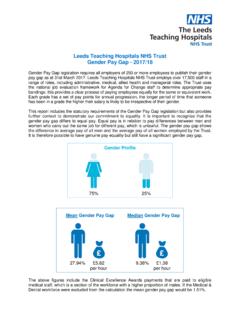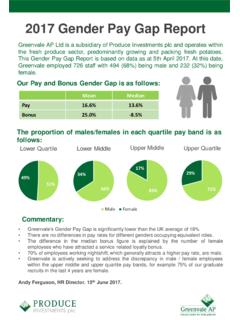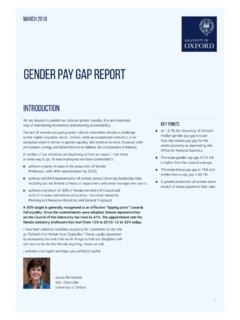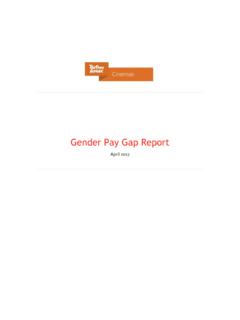Transcription of A feminist government, but gender gaps remain - …
1 The 2017 OECD report The Pursuit of gender Equality: An Uphill Battle explores how gender inequalities persist in social and economic life around the world. Young women in OECD countries have more years of schooling than young men, on average, but women are less still likely to engage in paid work. Gaps widen with age, as motherhood typically has negative effects on women's pay and career advancement. Women are also less likely to be entrepreneurs, and are under-represented in private and public leadership. In the face of these challenges, this report assesses whether (and how) countries are closing gender gaps in education, employment, entrepreneurship, and public life. The report presents a range of statistics on gender gaps, reviews public policies targeting gender inequality, and offers key policy recommendations.
2 A feminist government, but gender gaps remain Canada s current government has declared itself as feminist and has sought to advance the cause of gender equality through the use of its pioneering tool gender -Based Analysis Plus (GBA+). Parliament has taken an active role in promoting gender -based analysis and in scrutinizing the gender impacts of policy and programs. And while women are still heavily underrepresented in Parliament (only 26% of Canada s MPs are women, compared to an OECD average of 29%), there is gender parity in the Cabinet an important step for ensuring women s voices are properly heard. Still, challenges remain . Women in Canada earn 60% of bachelor s degrees, but are still lagging behind in doctoral studies and remain underrepresented in science, technology, engineering and mathematics (STEM) fields.
3 In 2015, roughly 38% of Canadian STEM graduates were women. This rate is above the average for OECD countries, but still leaves room for improvement. In the labour market, Canada has one of the smallest gender employment gaps in the OECD and is relatively successful at getting women into management positions [Chapter 11]. However, the gender wage gap is considerably larger than the OECD average [Chapter 12]. In 2015, the average Canadian full-time female employee earned around 81 cents to the average full-time male employee s dollar a gap that has changed very little over the past decade or so. The Canadian government is taking good steps to make gender equality a reality on the ground. However, Canada can do more, particularly in areas like leave reserved for fathers or second parents and advancing pay equity across Canada.
4 gender pay gap, 2015 or latest available year Notes: gender gap in median earnings for full-time employees. The gender gap is defined as the difference between male and female median monthly earnings divided by male median monthly earnings for full-time employees. Data for Canada are based on weekly earnings. See [Figure ] 0102030405060 gender pay gap (%) Contacts: Willem Adema (+33 1 45 24 15 57; Valerie Frey (+33 1 45 24 91 90; Summary indicators of gender equality Notes: BEL = Belgium, FIN = Finland, ISL = Iceland, ISR = Israel, JPN = Japan, KOR = Korea, LVA = Latvia, NOR = Norway, POL = Poland, SWE = Sweden, TUR = Turkey In a survey carried out for The Pursuit of gender Equality, governments identified the three most important gender inequality issues in their country as violence against women, the gender wage gap, and the unequal sharing of unpaid work.))
5 Many OECD countries are now prioritizing these issues in policy, and many are also pushing to get more women into public and private sector leadership. Immigrant integration through employment Employment rates for foreign-born women, 2014-15 More than half ( ) of immigrants to Canada are women and flows have remained stable from 2010 to 2015 [Chapter 21]. As a traditional settlement country, Canada does relatively well at providing immigrant women with employment opportunities employment rates for immigrant women in Canada are higher than the OECD average and relatively close to ( lower than) those for native-born women. Settlement programs that combine childcare with skills training, as well as access to entrepreneurship supports, help migrants with their integration and can increase employment rates among migrant women.
6 Notes: See [Figure ]. Canadian girls and women lagging in STEM and financial literacy gender gaps in PISA maths scores, 2015 While women earn more bachelor s degrees than men in Canada, there are lower proportions of women in STEM fields and in doctoral studies. Canadian girls and women perform worse than their male peers in mathematics as teenagers, and these gaps become greater as they move into adulthood [Chapter 6]. Canadian women also have lower scores in financial literacy. A lack of financial knowledge may correlate with lower financial resilience, with women in Canada less likely to report an ability to cope with financial shocks than men. Improving women s financial knowledge could help them set up more successful financial strategies to face negative shocks.
7 Notes: All shown differences are statistically significant at p< See [Figure ]. gender equality in Canada A false choice parental leave in Canada The Canadian Parliament is increasingly active as a champion for gender equity and in 2016 formed the Special Committee on Pay Equity, which conducted hearings on pay equity and proposed a plan that would inform pay equity legislation for workers in the federal jurisdiction. Furthermore, the Auditor General of Canada has been active in advocating for closing gender gaps and meeting international commitments related to gender based analysis, closing gender gaps and advancing gender equality in Canada Men s take-up of parental leave in Canada (shareable between parents) is low. Fathers often earn more than their partners, therefore unless leave benefits (almost) fully replace previous earnings, it usually makes economic sense for the mother to take the bulk of the leave.
8 To achieve greater gender equality within families Canada could introduce dedicated paid paternity leave reserved just for fathers, and increase the replacement rate of benefits. Canada is currently in the process of extending the duration of parental leave benefits (to 18 months, at a lower payment rate, beginning in 2018), but this is not expected to have a large impact on men s use of parental benefits. av (SWE) (POL) (FIN) (LVA) (BEL) (NOR) (ISL)Bottom (JPN) (JPN) (TUR) (KOR) (KOR) (ISR) (JPN)Female share (%) of seats in parliamentFemale share (%) of Bachelor s graduatesFemale share (%) of Bachelor s graduates in STEMG ender gap ( ) in the labour force participation rateFemale share (%) of managersGender pay gap (median earnings, full-time employ ees, %) gender gap ( ) in the share of w orkers w ho are employ ers020406080100 FranceOECDU nited StatesCanadaIceland% -10-5051015202530 FinlandOECDU nited StatesCanadaAustriaGender gap (male minus female)
















